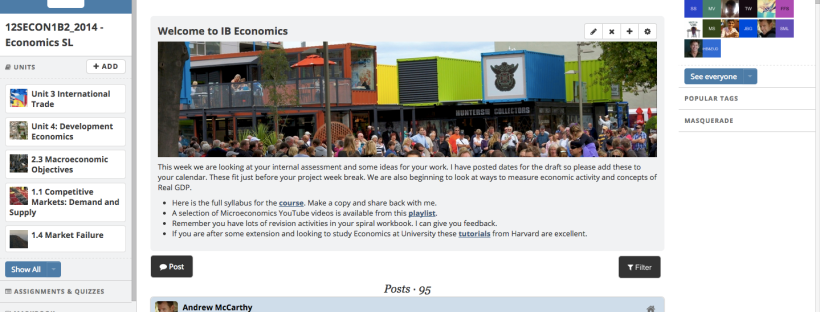Originally published in UWCSEA Dunia Magazine: co-authored with Adrienne Michetti
Since its inception in 2011, UWCSEA’s iLearn initiative has broadened our scope of 21st century learning. While our early focus was on providing students with necessary digital tools and supporting teachers to use technology effectively, over time it became clear that our traditional classrooms were expanding to encompass a variety of online spaces. One valuable effect of this is that our online spaces allow for continued discussions and learning long after the bell has rung. Over the last three years we have used Google sites, documents, presentations and a variety of other web-based tools to help classroom learning continue online.
As our face-to-face classrooms in Middle School and High School evolved with the addition of laptop computers, it was inevitable that our online learning spaces would also evolve. During the 2012-2013 school year, we began to research and evaluate how online environments might naturally extend face-to-face learning. We established working groups to test and pilot various platforms that would support ‘blended learning’ (the seamless amalgamation of face-to-face and online learning).
Research suggests that blended learning environments can be beneficial to student learning under the right conditions; that is, when they combine the best of face-to-face learning and online learning. Blended learning environments need to have two key elements to be effective. First, the system must support asynchronous and constructive dialogues; i.e., they must allow students to collaborate and provide one another with feedback, even when they are not online at the same time. Secondly, there must be opportunities for learners to digest important content and teacher explanations before a face-to-face lesson (Luckin et al, 2012). Our vision at UWCSEA is to provide online tools at an institutional level, accessible by all teachers and students, to support this emerging best practice.
The result of our working groups’ research and development has been this academic year’s soft-launch of our new UWCSEA Online Learning Platform. At our East Campus, the Online Learning Platform replaces and expands the components of East Curriculum Online, and at our Dover Campus, it supersedes StudyWiz and other Google Sites in the Middle and High School.
A primary reason for needing a new online learning environment was to increase opportunities for communication, collaboration, and socialisation around learning now that our face-to-face classrooms had evolved. Further, we recognized a need to provide ready access to curriculum content resources such as unit outlines, teacher instructions, or multimedia materials. Long term, it will also allow us to more effectively collect and give feedback on student work, which will help us to expand the ways we might use student assessment for authentic learning. Already habits are changing: our Online Learning Platform has become a one-stop shop for learning and resources, resulting in a noticeable reduction in emails.
The Online Learning Platform is currently living and breathing in a variety of ways across the College Middle and High Schools. In Music, students are sharing example compositions with classmates, whilst some History and Economics classes are using it to encourage co-construction of meaning and collaboration. Science departments are developing units which allow students to progress flexibly with course material, or to review concepts ahead of class to activate prior learning.
All teachers using the Platform are now posting homework tasks online; doing so allows the Platform to synchronise information from each student’s multiple courses into one personalised calendar for him/her. As such, our students now have access to a dashboard all of their individual homework, allowing them to prioritise tasks and manage their time to meet deadlines and other extra-curricular commitments.
Over the last 12 months, UWCSEA’s Digital Literacy Team have worked closely with developers of “Teamie,” the Singapore company behind the Platform. We continue to work with them to tweak and enhance the Platform so as to effectively support learning at our College. We look forward to the continual evolution of our learning spaces, mindful of best practices for student learning with digital technologies.
Luckin, R., Bligh, B., Manches, A., Ainsworth, S., Crook, C., & Noss, R. (2012). Decoding learning: the proof, promise and potential of digital education. Retrieved from http://eprints.lancs.ac.uk/66044/

